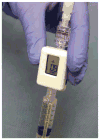EUS-guided portal pressure gradient measurement with a simple novel device: a human pilot study
- PMID: 27693644
- PMCID: PMC5611853
- DOI: 10.1016/j.gie.2016.09.026
EUS-guided portal pressure gradient measurement with a simple novel device: a human pilot study
Abstract
Background and aims: Portal hypertension (PH) is a serious adverse event of liver cirrhosis. The hepatic venous pressure gradient or portal pressure gradient (PPG) accurately reflects the degree of PH and is the single best prognostic indicator in liver disease. This is usually obtained by interventional radiology (IR), although it is not routinely performed. Recently, we developed a simple novel technique for EUS-guided PPG measurement (PPGM). Our animal studies showed excellent correlation between EUS-PPGM and IR-PPGM. We present the first human pilot study of EUS-PPGM in patients with liver disease.
Methods: EUS-PPGM was performed by experienced endosonographers using a linear echoendoscope, a 25-gauge fine-needle aspiration needle, and a novel compact manometer. The portal vein and hepatic vein (or inferior vena cava) were targeted using a transgastric-transduodenal approach. Clinical parameters of PH were evaluated in each patient. Feasibility was defined as successful PPGM in each patient. Safety was based on adverse events captured in a postprocedural interview.
Results: Twenty-eight patients underwent EUS-PPGM with 100% technical success and no adverse events. PPG ranged from 1.5 to 19 mm Hg and had excellent correlation with clinical parameters of portal hypertension including the presence of varices (P = .0002), PH gastropathy (P = .007), and thrombocytopenia (P = .036). PPG was increased in patients with high clinical evidence of cirrhosis (P = .005).
Conclusion: This novel technique of EUS-PPGM using a 25-gauge needle and compact manometer is feasible and appears safe. Given the availability of EUS and the simplicity of the manometry setup, EUS-guided PPG may represent a promising breakthrough for procuring indispensable information in the management of patients with liver disease.
Copyright © 2017. Published by Elsevier Inc.
Figures




Comment in
-
New common ground: EUS-guided portal pressure measurements as a bridge between endoscopy and hepatology.Gastrointest Endosc. 2017 May;85(5):1002-1004. doi: 10.1016/j.gie.2016.11.004. Gastrointest Endosc. 2017. PMID: 28411754 No abstract available.
References
-
- Sanyal AJ, Bosch J, Blei A, et al. Portal hypertension and its complications. Gastroenterology. 2008;134:1715–28. - PubMed
-
- Burroughs AK, McCormick PA. Natural history and prognosis of variceal bleeding. Baillieres Clin Gastroenterol. 1992;6:437–50. - PubMed
-
- D’Amico G, Garcia-Tsao G, Pagliaro L. Natural history and prognostic indicators of survival in cirrhosis: a systematic review of 118 studies. J Hepatol. 2006;44:217–31. - PubMed
-
- Thalheimer U, Bellis L, Puoti C, et al. Should we routinely measure portal pressure in patients with cirrhosis, using hepatic venous pressure gradient (HVPG) as a guide for prophylaxis and therapy of bleeding and rebleeding? No Eur J Intern Med. 2011;22:5–7. - PubMed
-
- Armonis A, Patch D, Burroughs A. Hepatic venous pressure measurement: an old test as a new prognostic marker in cirrhosis? Hepatology. 1997;25:245–8. - PubMed
MeSH terms
Grants and funding
LinkOut - more resources
Full Text Sources
Other Literature Sources
Medical

